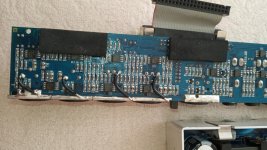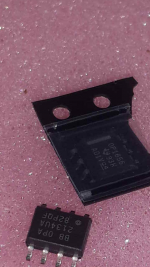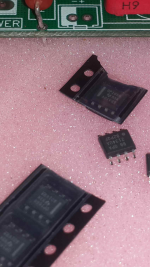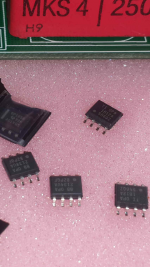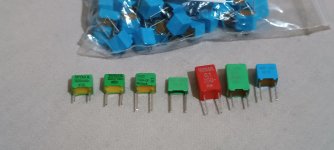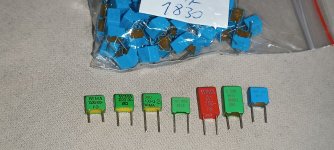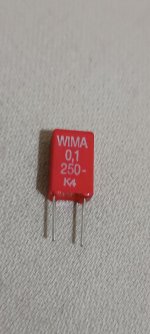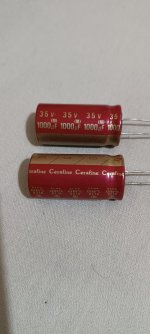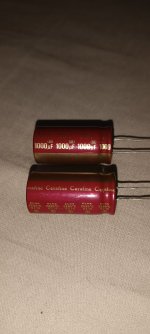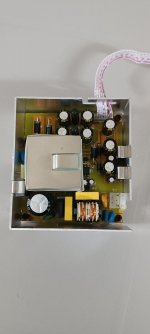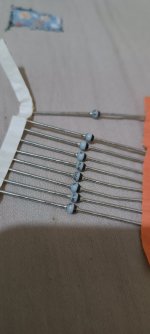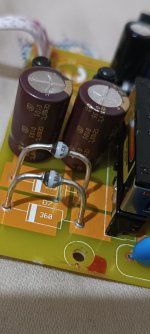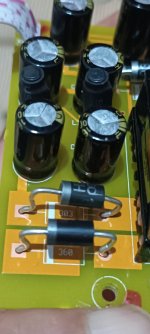+1
In this case, JT11EMCF direct connection. Even better, replace with AKM4396. Everything else being the same, it has a higher V out level and "drives" better.
The JT11EMCF is a cheap bifilar wound EI core transformer. I greatly prefer double bobbins UI, or L core transformers, as they have some great advantages over EI. First, much better covering the core with the winding would give much better coupling. For the same Pri inductance it also allows much lower Copper resistance and capacitance (of course, with all other associated parameters). The UI (and esp. L) cores efficiency and topology is much closer to torroids, but having an air gap they have much better overload characteristics. Another advantage is ability to wind those with humbucking arrangement, so they are much less susceptible to noises. Indeed, they are more expensive than EI--the cost of a single transformer would be more than cost of the Behringer, but then they are really worth it! I would never consider EI core transformer for any critical application even in 1:1 ratio...
As for 'drives better'--in general, whenever we want to use a transformer we always want to use the smallest core for the given signal overload on the low frequencies. The larger signal, the bigger core, which throws other parameters way off. So here the higher V level in 4396 is really a disadvantage. Between the AKM4393 and 4396 for all practical purposes we would want to use the same transformer. In this respect it will work better with 4393... but then it would probably be splitting nails...
Best, M
Last night I put two 1:1 transformers hooked directly to the balanced outputs of the AKM4393 going straight to the XLR outs. I believe, no capacitor/opamp swaps can come even close for the difference it makes...
February, 2007
Audiosmile Behringer DEQ2496 modification
January 2019
Audiosmile Modified Behringer SRC2496 | Hi-Fi Systems Reviews | HighFidelityReview - Hi-Fi systems, DVD-Audio and SACD reviews
and more...While the power supply is respectable for an inexpensive component, Simon added a LC filter circuit in order to smooth out the current flow from the power supply. The power supply modification for the Behringer does an excellent job at removing noise and spurious interference, resulting in a DAC that is capable of revealing the subtle shadings of a well-recorded disc.
Audiosmile / Behringer Mods
Behringer Mods - Upgrade DEQ2496, DCX2496, SRC2496
-> Behringer Mods - Upgrade DEQ2496, DCX2496, SRC2496


[PDF] https://www.behringermods.com/DEQ Instructions.pdf
Last edited:
February, 2007
Audiosmile Behringer DEQ2496 modification
January 2019
Audiosmile Modified Behringer SRC2496 | Hi-Fi Systems Reviews | HighFidelityReview - Hi-Fi systems, DVD-Audio and SACD reviews
and more...
Audiosmile / Behringer Mods
Behringer Mods - Upgrade DEQ2496, DCX2496, SRC2496
-> Behringer Mods - Upgrade DEQ2496, DCX2496, SRC2496


[PDF] https://www.behringermods.com/DEQ Instructions.pdf
thanks nichicon changed with fg 10uf 47uf
Attachments
The JT11EMCF is a cheap bifilar wound EI core transformer. I greatly prefer double bobbins UI, or L core transformers, as they have some great advantages over EI. First, much better covering the core with the winding would give much better coupling. For the same Pri inductance it also allows much lower Copper resistance and capacitance (of course, with all other associated parameters). The UI (and esp. L) cores efficiency and topology is much closer to torroids, but having an air gap they have much better overload characteristics. Another advantage is ability to wind those with humbucking arrangement, so they are much less susceptible to noises. Indeed, they are more expensive than EI--the cost of a single transformer would be more than cost of the Behringer, but then they are really worth it! I would never consider EI core transformer for any critical application even in 1:1 ratio...
As for 'drives better'--in general, whenever we want to use a transformer we always want to use the smallest core for the given signal overload on the low frequencies. The larger signal, the bigger core, which throws other parameters way off. So here the higher V level in 4396 is really a disadvantage. Between the AKM4393 and 4396 for all practical purposes we would want to use the same transformer. In this respect it will work better with 4393... but then it would probably be splitting nails...
Best, M
You are probably right on all accounts, seeing that you are professionally dealing with transformers et al. I, on the other side, am not an expert, by a long shot. My response was more in a sense that the transformer-direct coupled (even a "cheap" one ...although I non-expertly believe Jensen is not that bad!) does work better, IME. Basically supporting your own finding as a general concept. Are there better/more expensive/better suited transformers? Yes, I agree there are.
Anyway, thanks for the detailed reply.
You are probably right on all accounts, seeing that you are professionally dealing with transformers et al. I, on the other side, am not an expert, by a long shot. My response was more in a sense that the transformer-direct coupled (even a "cheap" one ...although I non-expertly believe Jensen is not that bad!) does work better, IME. Basically supporting your own finding as a general concept. Are there better/more expensive/better suited transformers? Yes, I agree there are.
Anyway, thanks for the detailed reply.
Conceptually, as opposed to opamp swap I greatly prefer a transformer for a simple reason it allows to remove negative feedback from the circuit. For that reason, another solution (much cheaper and quite elegant) would be discrete jFet buffer. It can be a simple cathode follower, CCS, or White follower--any of those sonically are quite neutral...
Best, M
Last edited:
I will be recapping and upgrading the opamps on my recently purchased DEQ2496.
I noticed that the digital board is v2.5. Based on the rigorous work of stef1777 of diyaudio and awdiy.com, I noticed that my board layout was different from the photos and descriptions he provided.
As such, I believe this may be the first DEQ2496 mod featuring the v2.5 board.
The AKM AK5393 ADC has been replaced with a Cirrus Logic CS5381-KZZ and the capacitors around this ADC now include a few 1uF 50V radials which were absent on the previous layout.
See attached photo of the digital board. I have annotated some of my plans, including how I plan to follow stef1777's suggestions to piggyback 10uF 10V OSCONS on some of the ceramic caps. It seems as if there are actually several more candidates for similar piggybacking or outright replacement which I have left without annotation.
I am excited to increase my electrical engineering knowledge as I am an economist by trade so I do have one initial question for the gurus of diyaudio - looking at frequency coefficients, it seems that 50V capacitors have higher (worse?) frequency coefficients versus their 25V cousins (usually on a datasheet you can see both variants side-by-side). I find it odd that there would be 50V caps on this board, especially when it seems this is the first time 50V caps have ever been used on the DEQ2496 (at least on the digital board). Can I use 25V instead? I know this is not a simple question, but perhaps my detailed photo and the experience of this community can help me answer this question.
Thanks!
(I have mostly settled on Elna Silmic II caps for the analog board's 47uF 25V caps, the (ridiculously) more expensive Panasonic OSCONS for the 10uF 25v caps on the digital board, and PPS Film caps for the 1n5, 2n2, and 390p ceramic smds. If I'm feeling sadistic, I may replace some of the 100n and 100p smds as well. There are a few others, for example, stev1777 suggested replacement of C1 10uF 25V on digital board with a 22uF 25V and 2.2uF 50V that I will need to choose as well - <strike>assuming that v2.5 C1 cap is the same as v2!</strike> *there are differences because the ADC is different, see post #12)
I have also included stev1777's awdiy.com picture of the v2 board so you can see the differences (at least some of them).
I'll leave the analog board for a separate post in this thread.
Deq2496 aes / Ebu ıc help
Attachments
ÒPA1656 is the latest, the cleanest, lowest distortion, lowest noise. A no-brainer!
Jan
Jan
Yakın zamanda satın aldığım DEQ2496'nın opamp'larını özetleyip yükselteceğim.
Dijital panonun v2.5 olduğunu fark ettim. diyaudio ve awdiy.com'dan stef1777'nin titiz çalışması sonucunda, pano düzenimin sağladığı fotoğraflardan ve açıklamalardan farklı olduğunu fark ettim.
Bu nedenle bunun v2.5 kartını kullanan ilk DEQ2496 modu olabileceğini düşünüyorum.
AKM AK5393 ADC, bir Cirrus Logic CS5381-KZZ ile değiştirildi ve bu ADC etrafındaki kapasitörler artık önceki düzende bulunmayan birkaç 1uF 50V radyal içeriyor.
Dijital kartın ekteki fotoğrafına bakın. Planlarımın bazılarını, stef1777'nin seramik kapaklardan bazılarının üzerine 10uF 10V OSCONS takma önerilerini nasıl takip edeceğimi de içeren açıklamalarla açıkladım. Görünüşe göre benzer şekilde ekleme veya tamamen değiştirme için birkaç aday daha var ve bunları açıklama yapmadan bıraktım.
Mesleğim gereği ekonomist olduğum için elektrik mühendisliği bilgimi artırmak için heyecanlıyım, bu yüzden diyaudio gurusuna ilk sorum şu olacak - frekans katsayılarına bakıldığında, 50V kapasitörlerin 25V kuzenlerine kıyasla daha yüksek (daha kötü?) frekans katsayılarına sahip olduğu anlaşılıyor (genellikle bir veri sayfasında her iki çeşidi yan yana görebilirsiniz). Bu kartta 50V kapasitörler olması tuhaf geliyor, özellikle de 50V kapasitörlerin DEQ2496'da ilk kez kullanılmış gibi göründüğünde ( en azından dijital kartta). Bunun yerine 25V kullanabilir miyim? Bunun basit bir soru olmadığını biliyorum, ancak belki de ayrıntılı fotoğrafım ve bu topluluğun deneyimi bu soruyu yanıtlamama yardımcı olabilir.
Teşekkürler!
(Analog kartın 47uF 25V kapasitörleri için çoğunlukla Elna Silmic II kapasitörleri, dijital karttaki 10uF 25V kapasitörleri için (gülünç derecede) daha pahalı olan Panasonic OSCONS'ları ve 1n5, 2n2 ve 390p seramik smd'ler için PPS Film kapasitörleri seçtim. Eğer sadist hissediyorsam, 100n ve 100p smd'lerin bazılarını da değiştirebilirim. Birkaç tane daha var, örneğin, stev1777 dijital karttaki C1 10uF 25V'un 22uF 25V ve 2.2uF 50V ile değiştirilmesini önerdi, bunları da seçmem gerekecek - <strike>v2.5 C1 kapasitörünün v2 ile aynı olduğunu varsayarak!</strike> *ADC farklı olduğu için farklılıklar var, 12 numaralı gönderiye bakın )
Ayrıca stev1777'nin awdiy.com'daki v2 kartının resmini de ekledim, böylece farkları (en azından bazılarını) görebilirsiniz.
Analog kartı bu başlık altında ayrı bir yazıda ele alacağım.
Yakın zamanda satın aldığım DEQ2496'nın opamp'larını özetleyip yükselteceğim.
Dijital panonun v2.5 olduğunu fark ettim. diyaudio ve awdiy.com'dan stef1777'nin titiz çalışması sonucunda, pano düzenimin sağladığı fotoğraflardan ve açıklamalardan farklı olduğunu fark ettim.
Bu nedenle bunun v2.5 kartını kullanan ilk DEQ2496 modu olabileceğini düşünüyorum.
AKM AK5393 ADC, bir Cirrus Logic CS5381-KZZ ile değiştirildi ve bu ADC etrafındaki kapasitörler artık önceki düzende bulunmayan birkaç 1uF 50V radyal içeriyor.
Dijital kartın ekteki fotoğrafına bakın. Planlarımın bazılarını, stef1777'nin seramik kapaklardan bazılarının üzerine 10uF 10V OSCONS takma önerilerini nasıl takip edeceğimi de içeren açıklamalarla açıkladım. Görünüşe göre benzer şekilde ekleme veya tamamen değiştirme için birkaç aday daha var ve bunları açıklama yapmadan bıraktım.
Mesleğim gereği ekonomist olduğum için elektrik mühendisliği bilgimi artırmak için heyecanlıyım, bu yüzden diyaudio gurusuna ilk sorum şu olacak - frekans katsayılarına bakıldığında, 50V kapasitörlerin 25V kuzenlerine kıyasla daha yüksek (daha kötü?) frekans katsayılarına sahip olduğu anlaşılıyor (genellikle bir veri sayfasında her iki çeşidi yan yana görebilirsiniz). Bu kartta 50V kapasitörler olması tuhaf geliyor, özellikle de 50V kapasitörlerin DEQ2496'da ilk kez kullanılmış gibi göründüğünde ( en azından dijital kartta). Bunun yerine 25V kullanabilir miyim? Bunun basit bir soru olmadığını biliyorum, ancak belki de ayrıntılı fotoğrafım ve bu topluluğun deneyimi bu soruyu yanıtlamama yardımcı olabilir.
Teşekkürler!
(Analog kartın 47uF 25V kapasitörleri için çoğunlukla Elna Silmic II kapasitörleri, dijital karttaki 10uF 25V kapasitörleri için (gülünç derecede) daha pahalı olan Panasonic OSCONS'ları ve 1n5, 2n2 ve 390p seramik smd'ler için PPS Film kapasitörleri seçtim. Eğer sadist hissediyorsam, 100n ve 100p smd'lerin bazılarını da değiştirebilirim. Birkaç tane daha var, örneğin, stev1777 dijital karttaki C1 10uF 25V'un 22uF 25V ve 2.2uF 50V ile değiştirilmesini önerdi, bunları da seçmem gerekecek - <strike>v2.5 C1 kapasitörünün v2 ile aynı olduğunu varsayarak!</strike> *ADC farklı olduğu için farklılıklar var, 12 numaralı gönderiye bakın )
Ayrıca stev1777'nin awdiy.com'daki v2 kartının resmini de ekledim, böylece farkları (en azından bazılarını) görebilirsiniz.
Analog kartı bu başlık altında ayrı bir yazıda ele alacağım.
C18 c19 All version cards are 100nf
ÒPA1656 is the latest, the cleanest, lowest distortion, lowest noise. A no-brainer!
Can I use non polar capacitor instead of 1uf capacitor
Can I use non polar capacitor instead of 1uf capacitor
Attachments
- Home
- Source & Line
- Digital Line Level
- DEQ2496 V2.5(!) (2017) Recap and Opamp Upgrade

